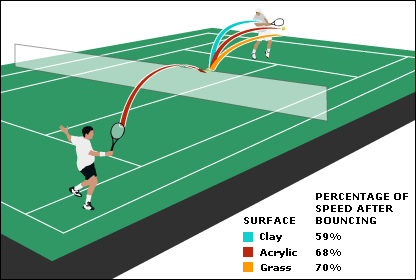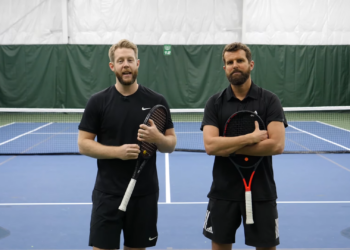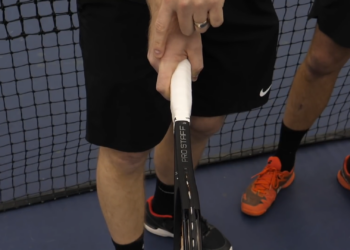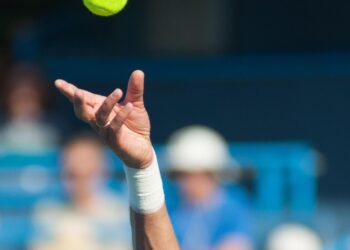Ever feel like you have no idea where to aim the serve?
I’ve been there and I’ve coached thousands of players who’ve felt the exact same way.
You spend hours grooving your serve, but when it’s match time, you’re left wondering: Should I go flat down the T? Slice out wide? Hit a safe kick serve? And let’s be honest, guessing isn’t a strategy.
The difference between a serve that wins points and one that sets you up to fail is about knowing when to hit what, and where to place it.
That’s exactly what we’re diving into here.
This guide is your roadmap to mastering serve tactics: we’ll cover the key serve types, strategic placement, and how to build a game plan that keeps opponents off balance.
You’ll get practical drills, myth-busting truths (like why blasting harder isn’t always better), and insights that most players never think about.
If you’re ready to serve smarter, not just harder, and finally feel confident with every toss, you’re in the right place.
Let’s raise your serve IQ and turn that frustration into a true competitive edge.
Why Smart Serve Strategy Outplays Power
There’s a stubborn myth floating around tennis circles that the fastest serve always wins. Let’s crush that right now: power without purpose is pointless.
Sure, it feels great to blast a serve past your opponent, but unless you’re a 6-foot-6 pro who can regularly crack 130 mph, relying on raw speed alone is a recipe for frustration.
What really wins points, especially at the beginner and intermediate levels, is smart placement and tactical variety.
“What if my opponent starts reading my serve?”
The answer is to serve smarter. Mixing up placement (T, wide, body), spins (flat, slice, kick), and even your rhythm keeps opponents guessing and off-balance. Strategy makes your serve unpredictable and that’s where the real power comes from.
The Three Core Serve Types – What They Are and When to Use Them
Mastering your serve starts with understanding your core tools. Each type of serve brings its own advantages and knowing when to use them is what separates smart players from predictable ones.
The Flat Serve
The flat serve is your power punch. It’s a speed-focused, low-spin serve that zips through the court with minimal curve. This is the one you see pros unleash when they’re gunning for a clean ace.
When to use it: Flat serves shine as first serves, especially on faster surfaces like hard courts or grass, where speed is amplified.
Best placement: Your go-to targets? Down the T to jam your opponent or out wide to stretch them for that elusive ace.
Pro Tip: I love using the flat serve early in matches to catch opponents off guard – nothing like setting the tone with a statement serve.
Caution: This serve comes with a higher risk of errors. Beginners and intermediates should use it selectively; it’s easy to overdo and end up with double faults.
The Slice Serve
The slice serve is your spin master, curving away from your opponent with wicked side spin. It’s perfect for dragging your opponent off the court and creating open space for your next shot.
When to use it:
This is your weapon against players with weaker backhands or anytime you want to pull your opponent wide to set up the next point.
Best placement:
It’s killer wide on the deuce side and super annoying into the body where it jams the returner up.
Serve & Volley Alert:
Thinking of storming the net? The slice serve is a great partner for the serve & volley tactic because it buys you time and pulls your opponent out of position.
The Kick Serve
Ah, the kick serve, your high-bouncing topspin hero. It’s all about safety and consistency, but with enough action to keep opponents uncomfortable.
When to use it:
This is your go-to second serve or your best friend when you need a reliable option under pressure.
Best placement:
Aim wide on the deuce side or go deep to the backhand side – both force your opponent to handle that awkward, shoulder-high bounce.
Myth-Buster:
“I’m not tall enough to hit a great kick serve.” Total nonsense. With the right technique, anyone can develop a killer kick serve and we’ve helped players of all sizes prove it.
Knowing what to serve and when is half the battle – get these three types dialed in, and you’re building a serve strategy that’s anything but predictable.
Serve Placement 101 – Where to Aim and Why
Dialing in your serve type is just the start, where you aim it is what really determines whether you’re setting up a winner or digging yourself a hole. Let’s break down the key targets and the tactics behind each one.
Targeting the Backhand Side
Most players instinctively aim for the opponent’s backhand and for good reason. The backhand is often the weaker, less comfortable side, especially for recreational players.
A well-placed serve to the backhand can produce short returns or even outright errors.
But here’s the catch: overusing this strategy can backfire fast.
If you become predictable, even a shaky backhand returner will start anticipating and neutralizing your serves.
Community Q: How do I know if my opponent’s backhand is actually weaker?
Watch closely in the warm-up and early rallies. Are their backhand swings shorter, slower, or more defensive? Do they chip rather than drive?
These are red flags. But stay sharp – good players will hide their weaknesses, so adjust your plan if they start hurting you off that side.
Targeting the Forehand Side
The forehand side can be your secret weapon.
When to surprise? Anytime your opponent is sitting on their backhand and cheating toward that side. A sudden serve to the forehand catches them off-balance and forces them to adjust late.
Tactical insight: Big hitters love to unload on forehand returns, but they often struggle if you jam them for time.
A flat serve to the forehand hip, especially when they’re not expecting it, can rush even the best players and produce weak replies.
Body Serves: The Underused Weapon
If you’re not using body serves, you’re missing out on one of the most disruptive, low-risk plays in tennis.
Aiming right at your opponent’s torso ties up their swing, forcing awkward, jammed returns. This is especially brutal against tall players who struggle to get out of the way.
It’s also your best friend in windy conditions, where aiming wide becomes risky, keeping it body-centered reduces margin for error and keeps your opponent pinned.
Community Q: “How can I disguise my serve to the body better?”
Great question. The key is to keep your toss and motion identical to your wide and T serves. Don’t telegraph the direction, same routine, same toss, but a subtle last-second angle change with your racket face.
Bonus: mix in body serves after a few wide ones to keep your opponent guessing.
Serve & Volley Tactics
The serve & volley is tennis’s ultimate pressure play, but timing is everything. When to deploy?
Fast courts are your playground here, or anytime you’ve established a pattern (like pulling your opponent wide a few times in a row).
How to execute:
- Serve placement: A wide slice serve is ideal because it drags your opponent off court, creating huge angles for your volley.
- Footwork: Explode forward as soon as you hit your serve. Stay low, keep your eyes up, and aim your first volley deep and cross-court.
Addressing the worry: “What if I get passed every time?”
Here’s the truth: yes, you will get passed sometimes. But serve & volley success is about forcing your opponent to hit low-percentage passing shots under pressure.
Stay disciplined, mix up your serve spots, and don’t abandon ship after a couple of passes. When done right, serve & volley keeps you in control and plants seeds of doubt in your opponent’s mind.
Mastering serve placement is not just hitting targets, you read your opponent, adjust your patterns, and keep them off balance from first serve to match point.
First vs. Second Serves – Crafting a Dual-Serve Strategy
One of the fastest ways to level up your game is to stop thinking of your first and second serves as just “hit it hard” vs. “get it in.” The best players have a dual-serve strategy that’s calculated, not just reactive.
First Serve Goals
Your first serve is your opportunity to steal easy points, but there’s a fine balance between aggression and recklessness.
The goal? Maximize free points while keeping your first-serve percentage high enough that you’re not living on your second serve.
Here’s what I tell my students: you want to hit your first serve with intent, but smart intent.
Use placement and variety, flat down the T, slice out wide, or even a big body serve, to keep opponents guessing. A first serve is about setting the tone of the rally or ending the point outright.
Pro insight: Want to know if your first serve is really working? Track your first-serve percentage and outcomes.
Write down how often you’re landing your first serve and how many points you’re actually winning off it. A 70% first-serve rate is great, unless you’re only winning half of those points. Data doesn’t lie, and it’ll help you adjust your serve plan for real results.
Second Serve Tactics
Here’s where the real magic happens.
Most players panic on their second serve and just push it in. But playing it safe isn’t always smart, a predictable, soft second serve invites aggressive returns and puts you on defense right away.
So how do you stay aggressive without risking double faults? The answer is spin and placement.
That’s why the kick serve is so valuable: it gives you margin over the net while still forcing opponents to handle a tricky, high-bouncing ball. You can also mix in a slice second serve to keep them honest.
Community worry: “How do I reset mentally after a double fault streak?”
We’ve all been there, it’s frustrating and can mess with your head. My best advice? Have a simple, reliable second-serve routine you can fall back on.
Step back, take a deep breath, and reset your focus to the process – good toss, good spin, solid follow-through. And remember, no one wins a match by avoiding mistakes, they win by staying composed and executing under pressure.
A dual-serve strategy gives you confidence because you know what your mission is every time you step up to the line: attack smartly on the first serve, and stay solid and disruptive on the second.
Match Conditions That Change Your Serve Strategy
A smart serve strategy isn’t one-size-fits-all, it’s fluid. To really dial in your serve effectiveness, you’ve got to adjust based on who you’re playing and the conditions you’re playing in. Let’s break down how to tweak your plan on the fly.
Adjusting for Opponent Type
Every opponent brings different challenges and your serve should be tailored to exploit their style.
- Pushers: These players love to get every ball back, often with a floating, defensive return. The key? Use deep, high-kick serves to push them even further back and set up easy put-aways.
- Junk-ballers: Their weird spins and awkward contact can mess with your rhythm. Keep them off-balance with varied placements, wide, body, and T, and don’t let them settle into a pattern.
- Aggressive baseliners: These players want to attack your serve early. Against them, mixing speeds and spins is critical. A body serve works wonders to jam their big swings, and serving out wide can stretch them, making it harder to step in.
Surface Speed Adjustments
The court you’re playing on can completely change your serve’s behavior.
- Grass: Fast and low-bouncing. Flat and slice serves skid through the court, making them super effective.
- Clay: Slower and higher-bouncing. The kick serve shines here, jumping up high and disrupting rhythm. You’ll also need to rely more on placement and spin rather than speed.
- Hard: The middle ground. All serve types work well, but your choice should be guided by your opponent’s weaknesses and the match situation.
Wind, Heat, and Humidity
Mother Nature always has a say in your serve.
Wind: This is where your serve can fall apart if you’re not prepared. A few key tweaks:
- Lower your toss slightly to prevent it from drifting.
- Add extra spin for control – kick and slice serves hold up better than flat serves in gusty conditions.
Heat & Humidity: These sap your energy fast, which can wreck your form and focus. Hydrate like crazy and keep your toss consistent. Heavy air can also slow down flat serves, so don’t be afraid to use more spin to maintain control.
Community Q: “How do I develop a reliable serve under windy conditions?”
Great question. The secret is to simplify your motion and shorten your toss. Practice hitting targets with a lower toss and focus on high-percentage spin serves.
Bonus tip: practice in the wind whenever possible so you’re not caught off guard on match day.
Staying adaptable is what keeps your serve sharp, no matter the challenge. When you learn to read the room, the opponent, the court, the weather, you stay one step ahead, every time.

Source -> BBC Sports
Bonus: Serve Strategy Cheat Sheet for Match Day
Sometimes, when you’re in the heat of a match, it’s easy to forget your serve plan.
That’s why I always recommend having a simple, quick-reference cheat sheet in mind, something you can fall back on when the pressure’s on.
Here’s your go-to guide to make smart, confident serve choices, no matter the situation:
🎾 Serve Strategy Cheat Sheet:
Opening Game:
- Serve Type: Flat
- Placement: Down the T
- Pro Tip: Set the tone early.
Opponent Struggling Backhand:
- Serve Type: Slice or Kick
- Placement: Wide to backhand
- Pro Tip: Keep attacking the weakness.
Facing Break Point:
- Serve Type: Kick
- Placement: High & deep
- Pro Tip: Stay aggressive but smart.
Serve & Volley Play:
- Serve Type: Slice
- Placement: Wide
- Pro Tip: Close in fast after serving.
When Fatigue Sets In:
- Serve Type: Kick
- Placement: Safe, deep to body
- Pro Tip: Focus on control over power.
Tape this into your tennis bag (or just lock it into your brain), and you’ll always have a strategy-first mindset, no more guesswork, just confident, purposeful serving from the first point to the last.
Your Serve Strategy Roadmap
Let’s wrap it up with the biggest lesson of all: serve strategy beats serve speed, every single time.
Whether you’re a beginner working on your basics or an intermediate player, the key to breaking through is developing a smart, adaptable game plan.
So here’s my challenge to you: start experimenting.
Mix up your placement, test out different serve types, and track what works.
Pay attention to your opponent’s reactions and make every serve part of a bigger strategy, not just a shot, but a statement.
If you’re ready to take your serve (and your entire game) to the next level, you are ready for PlayYourCourt.
Grab a 7-day free trial of PlayYourCourt membership and see firsthand how fast you can level up when you’ve got the right plan, and the right team, behind you.
Let’s make your next match your best yet.



